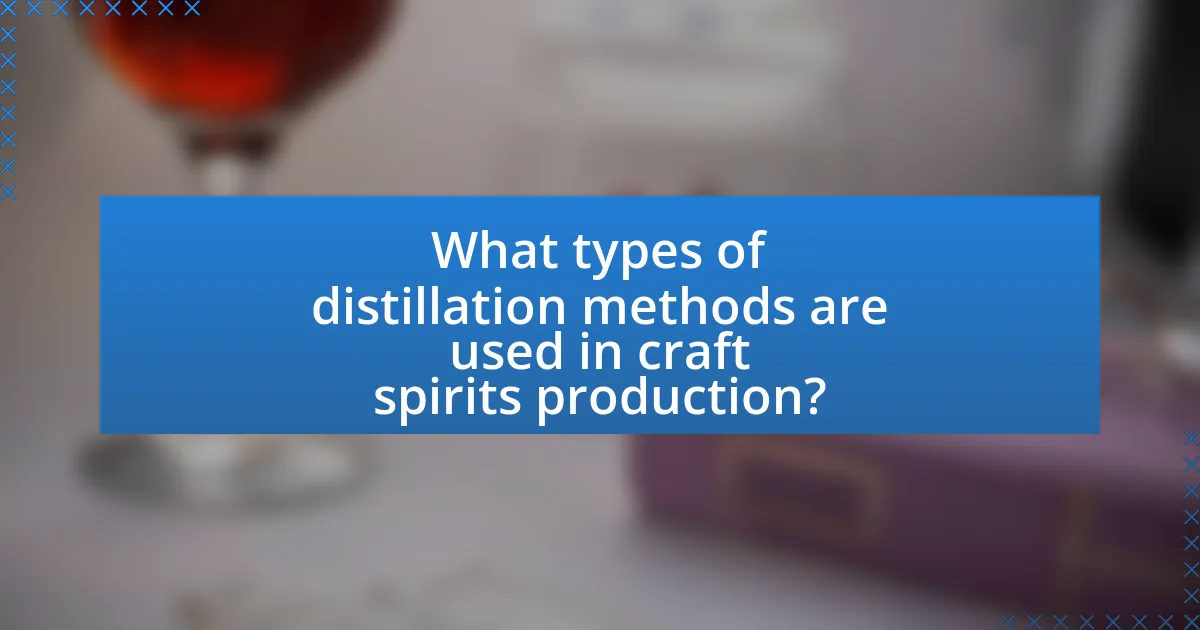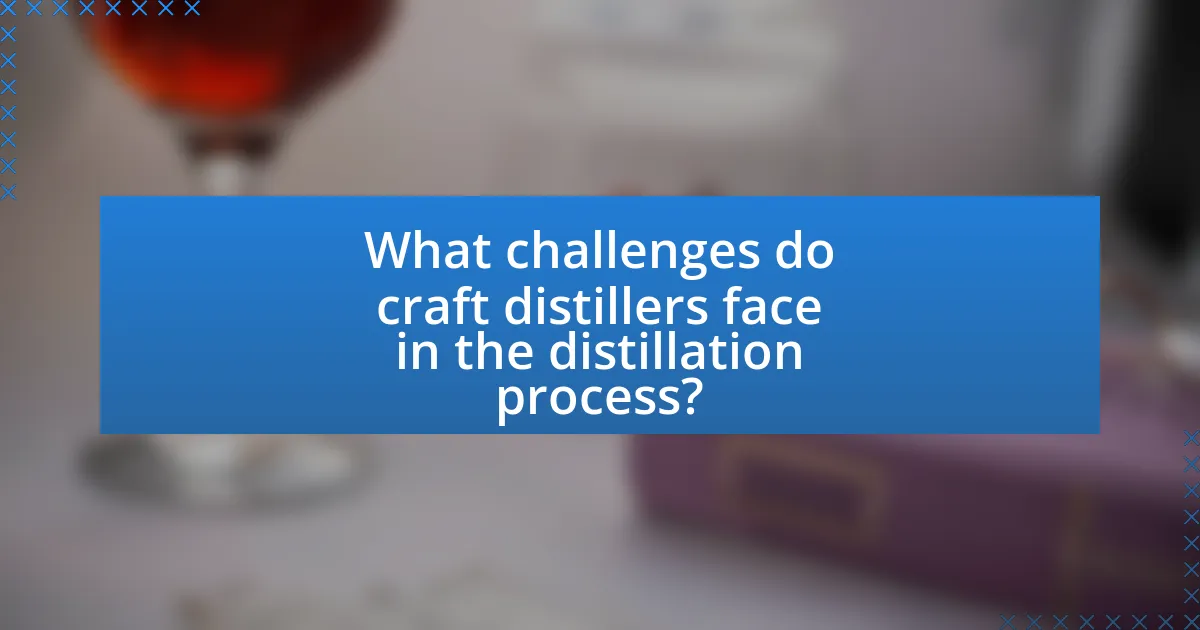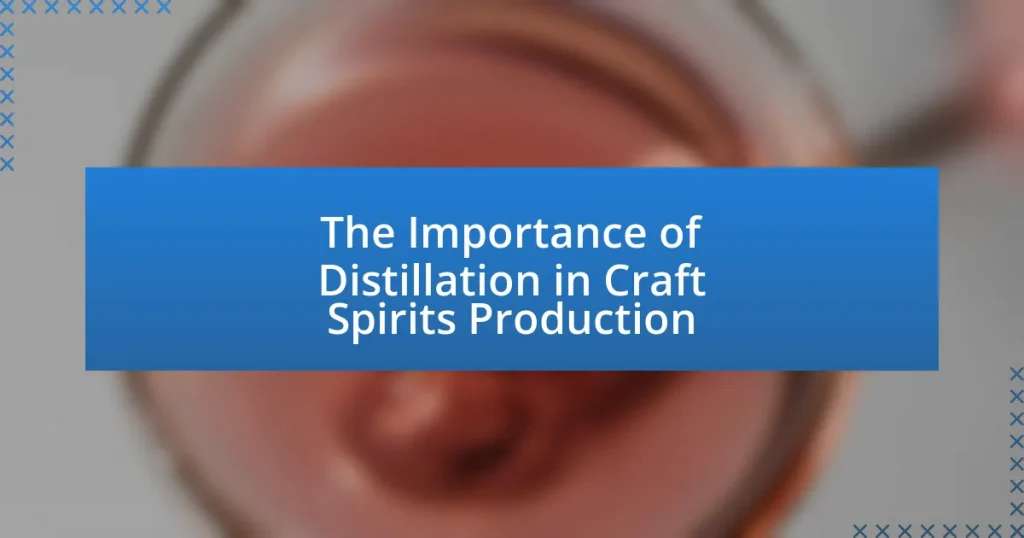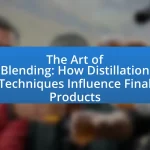The article focuses on the critical role of distillation in craft spirits production, highlighting its importance in separating alcohol from fermented mash, enhancing flavor profiles, and purifying the final product. It outlines the key stages of the distillation process, including heating, vaporization, condensation, and collection, while discussing how different distillation methods, such as pot still and column still, impact the quality and character of spirits. Additionally, the article addresses the challenges faced by craft distillers, best practices for optimizing distillation processes, and emerging innovations in distillation technology, emphasizing the balance between traditional techniques and modern advancements in the industry.

What is the role of distillation in craft spirits production?
Distillation is a crucial process in craft spirits production as it separates alcohol from the fermented mash, concentrating flavors and purifying the spirit. This method involves heating the mash to vaporize the alcohol, which is then cooled and condensed back into liquid form, resulting in a higher alcohol content and refined taste. Distillation not only enhances the purity of the spirit by removing impurities and unwanted compounds but also allows distillers to capture specific flavor profiles, contributing to the uniqueness of craft spirits. For example, traditional pot stills are often used in craft distilleries to create rich, complex flavors, while column stills can produce a cleaner, more neutral spirit.
How does distillation contribute to the quality of craft spirits?
Distillation significantly enhances the quality of craft spirits by concentrating desirable flavors and removing impurities. This process involves heating a fermented liquid to separate alcohol from water and other components, resulting in a higher purity and flavor profile. For instance, pot still distillation, commonly used in craft distilleries, allows for greater retention of the original ingredients’ character, leading to unique and complex flavor profiles. Additionally, distillation can achieve a higher alcohol content, which contributes to the overall mouthfeel and richness of the spirit. The precision of distillation techniques directly influences the final product’s taste, aroma, and smoothness, making it a critical factor in the production of high-quality craft spirits.
What are the key stages of the distillation process?
The key stages of the distillation process are heating, vaporization, condensation, and collection. During heating, the liquid mixture is heated to a temperature where the desired component vaporizes. In the vaporization stage, the vapor rises and separates from the liquid. Condensation occurs when the vapor cools and transforms back into liquid form. Finally, in the collection stage, the condensed liquid, known as distillate, is collected for further use. These stages are essential for separating components based on their boiling points, a principle that underlies the effectiveness of distillation in producing high-quality spirits.
How does the choice of distillation method impact flavor profiles?
The choice of distillation method significantly impacts flavor profiles by influencing the extraction of volatile compounds and the overall purity of the spirit. For instance, pot still distillation retains more congeners and flavor compounds, resulting in a richer and more complex flavor profile, as seen in traditional whiskey production. In contrast, column still distillation typically produces a higher alcohol content with fewer impurities, leading to a cleaner and lighter flavor, which is often preferred in vodka production. Studies have shown that the distillation method can alter the sensory characteristics of spirits, with pot stills contributing to a more robust mouthfeel and aromatic complexity compared to the smoother, neutral profiles achieved through continuous distillation.
Why is distillation considered essential in the craft spirits industry?
Distillation is considered essential in the craft spirits industry because it is the primary method for separating alcohol from fermented mixtures, thereby concentrating flavors and achieving desired alcohol content. This process allows distillers to refine raw ingredients, such as grains or fruits, into high-quality spirits with distinct characteristics. For instance, the distillation of whiskey involves multiple distillation runs to enhance purity and flavor complexity, which is crucial for crafting premium products. Additionally, distillation enables the removal of undesirable compounds, ensuring a smoother and more palatable final product.
What historical significance does distillation hold in spirit production?
Distillation holds historical significance in spirit production as it revolutionized the process of alcohol creation, allowing for higher purity and concentration of alcoholic beverages. This technique, first documented in the 8th century by Arab alchemists, enabled the transformation of fermented liquids into distilled spirits, which were more potent and had longer shelf lives. The introduction of distillation in Europe during the Middle Ages led to the development of various spirits, such as whiskey and gin, fundamentally shaping the beverage industry and cultural practices surrounding alcohol consumption.
How does distillation differentiate craft spirits from mass-produced alternatives?
Distillation differentiates craft spirits from mass-produced alternatives primarily through the methods and scale of production. Craft distillers often utilize traditional, small-scale distillation techniques, such as pot stills, which allow for greater control over the flavor profile and quality of the spirit. In contrast, mass-produced spirits typically employ continuous column stills, which prioritize efficiency and uniformity over nuanced flavor development.
For example, craft distillers may distill their spirits multiple times to enhance purity and complexity, while mass-produced brands often focus on maximizing output, resulting in a more generic taste. This distinction is supported by the American Distilling Institute, which emphasizes that craft spirits are defined by their artisanal production methods, including the use of high-quality ingredients and hands-on processes that reflect the distiller’s unique vision.

What types of distillation methods are used in craft spirits production?
Craft spirits production primarily utilizes two types of distillation methods: pot distillation and column distillation. Pot distillation involves heating the fermented mash in a pot still, allowing for a more traditional and hands-on approach, which often results in richer flavors and aromas. Column distillation, on the other hand, employs a continuous process using a column still, enabling higher efficiency and purity in the final product. Both methods are essential in crafting unique spirits, as they influence the flavor profile and alcohol content, with pot stills typically producing spirits with more character and column stills yielding a cleaner, higher-proof product.
What are the differences between pot still and column still distillation?
Pot still distillation and column still distillation differ primarily in their design and efficiency. Pot stills consist of a simple, traditional design that allows for batch distillation, typically producing spirits with more flavor and character, as seen in many craft distilleries. In contrast, column stills, also known as continuous stills, enable continuous distillation, resulting in higher alcohol yields and a purer spirit due to multiple distillation stages within the column. This efficiency is evidenced by the ability of column stills to produce large quantities of neutral spirits, which are often used in mass-produced liquors.
How does pot still distillation affect the character of the spirit?
Pot still distillation significantly influences the character of the spirit by allowing for a richer and more complex flavor profile. This method, which involves a single distillation process, retains more of the original ingredients’ characteristics, such as the grain or fruit used, compared to column still distillation. The pot still’s design facilitates the separation of volatile compounds, resulting in a spirit that often exhibits a fuller body and a more pronounced aroma. Historical evidence shows that spirits produced through pot still distillation, such as Scotch whisky and Irish whiskey, are renowned for their depth and complexity, often attributed to this traditional method.
What advantages does column still distillation offer for craft producers?
Column still distillation offers craft producers several advantages, including higher efficiency and greater control over the distillation process. This method allows for continuous operation, which can lead to increased production rates compared to traditional pot stills. Additionally, column stills enable precise separation of alcohol and other compounds, resulting in a cleaner and more consistent spirit. The ability to adjust the reflux ratio in column stills further enhances flavor profiles, allowing craft producers to tailor their products to specific market demands. These benefits contribute to improved quality and profitability in craft spirit production.
How do different distillation techniques influence the final product?
Different distillation techniques significantly influence the final product by affecting the purity, flavor profile, and alcohol content of the spirit. For instance, pot still distillation typically results in a richer, more complex flavor due to its batch process and lower distillation efficiency, allowing more congeners to remain in the final product. In contrast, column still distillation produces a higher purity spirit with a cleaner taste, as it allows for continuous distillation and better separation of alcohol from impurities. This difference in technique leads to variations in the sensory characteristics of spirits, such as whiskey, rum, and vodka, ultimately shaping consumer preferences and market positioning.
What role does temperature control play in the distillation process?
Temperature control is crucial in the distillation process as it determines the separation of components based on their boiling points. By precisely managing temperature, distillers can selectively vaporize and condense specific compounds, ensuring the desired flavor profile and purity of the final product. For instance, maintaining a lower temperature allows for the distillation of lighter, more volatile compounds, while higher temperatures can lead to the extraction of heavier, less desirable substances. This selective process is essential in craft spirits production, where the quality and characteristics of the spirit are directly influenced by the temperature settings during distillation.
How does the distillation cut affect the quality of the spirit?
The distillation cut significantly affects the quality of the spirit by determining which fractions of the distillate are collected during the distillation process. The “heads,” “hearts,” and “tails” represent different components of the distillation; the heads contain volatile compounds that can impart undesirable flavors, while the hearts contain the desirable ethanol and flavor compounds that define the spirit’s character. The tails, which contain heavier compounds, can also negatively impact quality if included in the final product.
Research indicates that precise cuts can enhance the overall flavor profile and smoothness of the spirit, as evidenced by distillers who carefully monitor temperature and time to optimize their cuts. For example, a study published in the Journal of Agricultural and Food Chemistry highlights that the optimal separation of these fractions can lead to a more refined and palatable spirit, confirming the critical role of distillation cuts in spirit quality.

What challenges do craft distillers face in the distillation process?
Craft distillers face several challenges in the distillation process, including limited access to high-quality raw materials, regulatory hurdles, and the need for specialized equipment. Limited access to high-quality grains, fruits, or other base ingredients can hinder the production of premium spirits, as the quality of the final product is directly linked to the quality of these inputs. Regulatory hurdles, such as obtaining necessary permits and adhering to strict safety and labeling requirements, can complicate operations and increase costs. Additionally, the need for specialized equipment, which can be expensive and require skilled operators, poses a financial and operational challenge for many craft distillers. These factors collectively impact the efficiency and scalability of their production processes.
What are common pitfalls in the distillation of craft spirits?
Common pitfalls in the distillation of craft spirits include inadequate temperature control, poor fermentation practices, and improper cuts during distillation. Inadequate temperature control can lead to unwanted compounds being vaporized, affecting flavor and quality. Poor fermentation practices, such as insufficient yeast health or incorrect sugar levels, can result in low alcohol yields and undesirable flavors. Improper cuts, which involve deciding what portion of the distillate to keep, can lead to the inclusion of heads (unpleasant volatile compounds) or tails (less desirable flavors), compromising the final product’s quality. These pitfalls can significantly impact the overall character and marketability of craft spirits.
How can distillers ensure consistency in their products?
Distillers can ensure consistency in their products by implementing strict quality control measures throughout the production process. This includes standardizing raw materials, maintaining precise fermentation and distillation temperatures, and conducting regular taste tests to monitor flavor profiles. For instance, using the same grain source and water supply can minimize variations in the final product. Additionally, employing advanced technology such as gas chromatography can help analyze and maintain the chemical composition of spirits, ensuring that each batch meets established quality standards. These practices are essential for producing spirits that consistently meet consumer expectations and regulatory requirements.
What are the best practices for troubleshooting distillation issues?
The best practices for troubleshooting distillation issues include systematically identifying and analyzing the problem, adjusting operational parameters, and conducting thorough equipment inspections. First, operators should gather data on the distillation process, such as temperature, pressure, and flow rates, to pinpoint anomalies. For instance, if the distillate purity is lower than expected, adjusting the reflux ratio or column packing may improve separation efficiency. Additionally, regular maintenance checks on equipment, including the still and condenser, can prevent issues caused by wear or contamination. Historical data shows that implementing these practices can enhance distillation performance and product quality, as evidenced by a study from the Journal of Food Engineering, which highlights the correlation between operational adjustments and improved distillate quality in craft spirits production.
How can craft distillers optimize their distillation processes?
Craft distillers can optimize their distillation processes by implementing precise temperature control and utilizing advanced distillation techniques. Precise temperature control allows distillers to separate desired compounds more effectively, enhancing flavor profiles and overall quality. Techniques such as fractional distillation enable the separation of components based on boiling points, which can improve the purity and character of the final product. Research indicates that optimizing these parameters can lead to a significant increase in yield and quality, as evidenced by studies showing that temperature variations can impact the concentration of volatile compounds in spirits.
What innovations are emerging in distillation technology?
Emerging innovations in distillation technology include the use of advanced automation, energy-efficient systems, and novel materials for distillation columns. Advanced automation allows for precise control over the distillation process, enhancing consistency and quality in spirit production. Energy-efficient systems, such as heat exchangers and vacuum distillation, reduce energy consumption and operational costs, making the process more sustainable. Additionally, the introduction of materials like ceramic and polymer membranes in distillation columns improves separation efficiency and reduces contamination risks. These innovations are supported by industry studies showing increased yield and reduced environmental impact in craft spirits production.
How can distillers balance tradition and modern techniques in their production?
Distillers can balance tradition and modern techniques by integrating time-honored methods with innovative technologies. For instance, they may use traditional pot stills to maintain flavor profiles while employing modern temperature control systems to enhance efficiency and consistency. This approach allows distillers to preserve the authenticity of their spirits while optimizing production processes. Historical examples include the use of hybrid stills, which combine traditional designs with modern engineering, resulting in spirits that reflect both heritage and contemporary quality standards.
What practical tips can enhance the distillation process in craft spirits production?
To enhance the distillation process in craft spirits production, distillers should focus on temperature control, equipment maintenance, and ingredient quality. Maintaining a consistent temperature during distillation ensures optimal separation of alcohol and impurities, which can significantly improve the final product’s flavor and purity. Regular maintenance of distillation equipment, such as cleaning stills and checking for leaks, prevents contamination and inefficiencies that can affect the distillation outcome. Additionally, using high-quality ingredients, including fresh botanicals and pure water, directly influences the flavor profile and overall quality of the spirits produced. These practices are supported by industry standards that emphasize the importance of precision and quality in distillation for achieving superior craft spirits.


